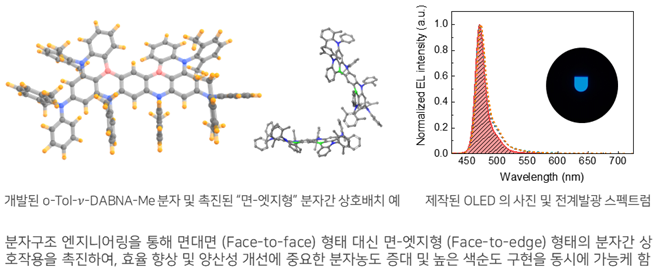
OLEDs are light-emitting devices that are being utilized as cutting-edge display technology, with various advantages such as clear image quality, thin profile, and the capability to fabricate flexible devices such as foldable or rollable displays.
In such applications, securing sufficient efficiency and lifespan of the red, green, and blue light sources that make up the three primary colors of light while also securing high color purity of the three primary colors is critical, but the technology to secure all these requirements in blue OLED devices is considered to be a big challenge.
Professor Seunghyup Yoo’s research team from the School of EE in collaboration with Professor Kim Yoon-hee’s research team from the Department of Chemistry at Gyeongsang National University succeeded in implementing a deep-blue organic light-emitting diode (OLED) device with the world’s highest level of efficiency.
Dr. Hyungseok Kim from Professor Yoo’s lab at KAIST (currently a visiting researcher from Kyushu University), Dr. Hyeong-jin Cheon from Gyeongsang National University (currently a visiting researcher at Imperial College London), and Donggyun Lee, a Ph.D. candidate from KAIST (in Professor Yoo’s lab), were the joint first authors of this study.
The research was published in the online version of the international journal ‘Science Advances’ on May 31, 2023. (Paper title: Toward highly efficient deep-blue OLEDs: Tailoring the multiresonance-induced TADF molecules for suppressed excimer formation and near-unity horizontal dipole ratio).
The team focused on the design of boron-based thermally activated delayed fluorescence materials, which are emerging as the next-generation emitters for the implementation of deep-blue OLED devices. These materials have the advantage of achieving excellent color purity, but due to their flat molecular structure, strong interactions between molecules can limit deep blue colors to low concentrations.
When the concentration of luminescent molecules is increased to secure sufficient efficiency for OLED devices, the issue of not being able to fully exploit the color purity advantage inherent in the emitters arises.
The research team not only simplified the synthesis process and improved the low yield compared to the conventional boron-based materials known to be very difficult to synthesize, but also successfully unveiled a molecular structure that can suppress intermolecular interactions from the perspective of molecular dynamics.
By implementing this through molecular design, the team solved the challenging issue of color purity and efficiency degradation. Unlike previous trials and errors that were carried out empirically, the research team established a comprehensive and analytical methodology, theoretically predicting structures that can lead to maximum efficiency, and successfully implemented a deep-blue OLED with more than 35% maximum external quantum efficiency by grafting the high-efficiency organic luminescent material they designed onto the device structure.
This is one of the world’s highest levels of efficiency for deep-blue OLED unit devices at this wavelength.
Professor Yoo commented, “Securing high-efficiency deep-blue OLED technology is one of the essential tasks in perfecting OLED displays as the ultimate technology, and this study is a good example that demonstrates the importance of systematic integrated research and collaboration between materials and device groups in solving challenges.”
